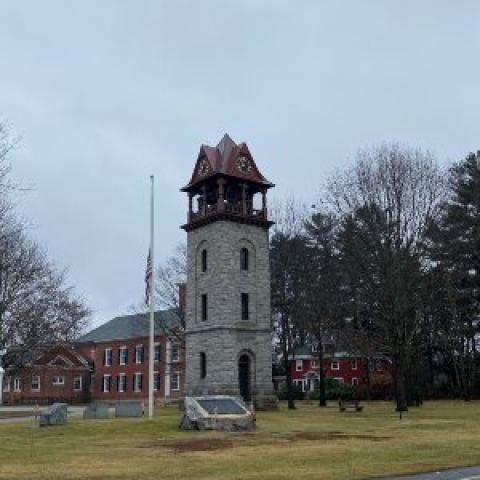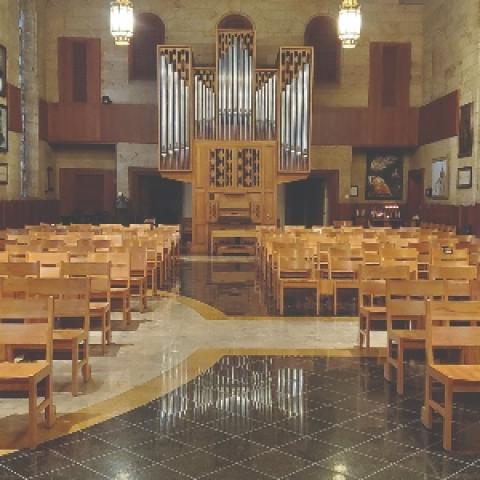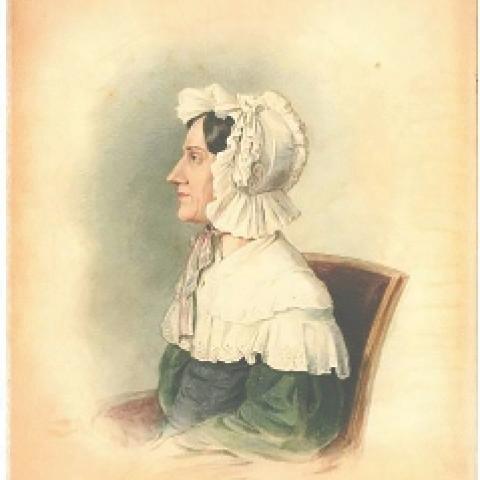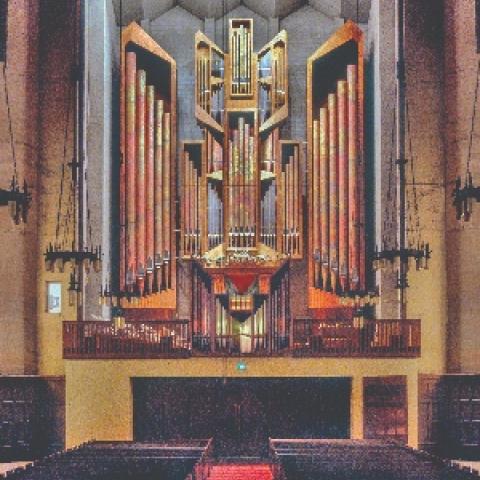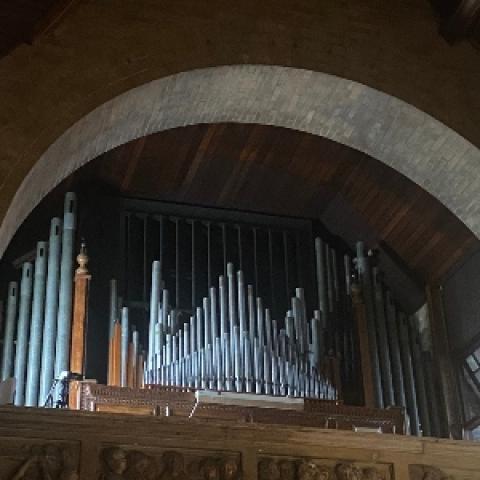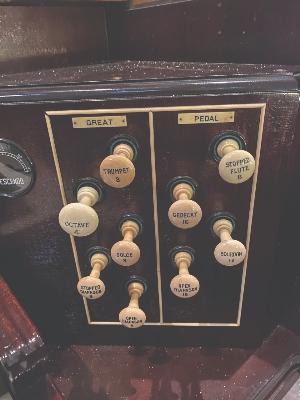
Listen to the voices.
Alan Laufman, who founded the Organ Clearing House in 1961, was in his final illness during the summer of 2000 when he asked me to join the company to help its work continue when he was finished. During that summer and fall, I sat with him for countless hours as he passed on the company lore and history, warning me of potential pitfalls and hinting about tricks he had picked up over the years. Among many other things, he warned that I would be spending a lot of time typing stoplists. When the company was young, he was working with a manual typewriter, carbon paper, and Wite-Out. (Remember those little bottles with a brush in the cap?) He kept a typewritten list of available organs: builder, year, location, number of manuals, number of stops. If you sent him a letter with $3.45 in stamps, he would send you a copy of the list. Updating the list meant retyping it completely. There were dozens of organs.
Happily, many stoplists are now available online from the websites of organ companies, churches, and the brilliant, comprehensive Pipe Organ Database created under the auspices of the Organ Historical Society (pipeorgandatabase.org), and it is easy to publish a stoplist on our website by attaching a link to a file or web page. “Click here to download specifications.” Still, I sometimes need to type the stoplist while referring to a photograph of the stop jambs. It is easy enough for a modest organ, but once you get over fifty stops, it takes a lot of flicking back and forth between screens to get it all accurately.
I review a dozen or more stoplists every time I spend a day at my desk. They are open as tabs on web browsers. I refer to them when talking on the phone. I type them, edit them, file them, and publish them. And while there are almost infinite variations, there are also similarities that apply to many American organs. I am often speaking or corresponding with people who have purchased an old church building who are altogether unfamiliar with organs, telling them how to gather the information I need to assess the marketability of an instrument. I might be speaking with a real estate developer sitting on the organ bench, mobile phone camera at the ready. I ask how many keyboards? “Three.” “Are there banks of knobs on either side of the keyboards?” “Yes.” “Do you see a group of knobs marked ‘Great’ on the right side?” “Yes.” “From the bottom up, you might read 8′ Diapason, 8′ Dulciana, 8′ Melodia, 4′ Octave, and so on?” “Exactly right. How did you know?” I just knew. It goes on: 4′ Flute d’Amour, 2′ Fifteenth, Mixture IV, 8′ Trumpet.
Is there one pedal stop? It is either Bourdon or Subbass, some smart people label it using the German Subbaß. Are there two pedal stops? I will bet lunch that it is one of these two pairs, 16′ Bourdon and 8′ Violoncello or 16′ Open Wood Diapason and 16′ Bourdon. How many three-manual organs have a Choir division that reads 8′ Concert Flute, 8′ Dulciana, 8′ Unda Maris, 4′ Flute, 8′ Clarinet? A ten-stop Swell division would have 8′ Viola da Gamba, 8′ Viole Celeste, 8′ Stopped Diapason, 4′ Principal, 2′ Octavin, Plein Jeu III, 16′ Bassoon, 8′ Trompette, 8′ Hautbois, and 4′ Clarion, a list that is familiar to thousands of organists.
Of course I am oversimplifying. I notice that my imaginary organ has 8′ Dulciana on both Great and Choir, fair enough because those are both common places to find that stop. If the organ was a little larger, we might have a Geigen Diapason on the Choir, or we might change the Great Dulciana to an Erzähler. One organ I played a lot when I was young had an 8′ English Diapason on the Choir. If the organ was a little larger, there would be an 8′ Diapason on the Swell, a few more independent Pedal stops like 16′ Principal, 8′ Octave, 4′ Choralbass (or Choralbaß), and 16′ Trombone. As I throw more stops at my imaginary organ, I am still using names that are common to many, even most American organs. So I raise the question, if pipe organ stoplists are so predictable, what’s new under the sun?
Making a list
If you leaf through a stack of printed stoplists, you will notice a common form that connects them all. Stops are separated by division, they are listed from lowest to highest pitches, maybe there is a mixture or two after the usual flues, and the reeds are last. When there are several flue stops of the same pitch, they are listed in order, principal, string, flute. The biggest apparent variety is the number of stops and number of divisions. So why don’t all organs sound alike?
Just like regional accents in any language, there are countless ways an organ stop like Principal or Gedeckt can sound. When an organ is being planned, the person or people responsible for how it will sound make decisions about what materials to use to make pipes, what wind pressures should be to complement the acoustics of the room and placement of the instrument, what scales should be used (the ratio between length and diameter of a pipe), and how each stop should be balanced with all the others.
The choice of materials is a good place to start. Hard metal like tin produces a bright tone; soft metal like lead produces a darker tone; and lead and tin are mixed in alloys through the spectrum. It is rare to find pipes made of pure tin because that metal is too hard to work with when doing the meticulous finicky work of voicing. Adding ten or twenty percent lead softens the metal enough to allow the voicer to manipulate the metal more easily, but the tone still benefits from the hardness. It is also rare, even a mistake, to make pipes of pure lead because the metal is so soft and heavy that the pipes cannot support their own weight. As the revival of classic organ building got rolling in the last third of the twentieth century, some organ pipes were made with such high lead content that the pipes collapsed after only a few years. Builders realized that when duplicating the high lead content found in antique pipes, they failed to consider that modern metallurgy produces purer materials while ancient lead was full of impurities. Throw a handful of impurity into the melting pot, and the lead gets stronger. It is the opposite of skimming the floating stuff off the top of your chicken stock pot.
The same applies to making wood pipes. Softwoods like spruce or fir produce darker tones, while hardwoods like oak or maple produce brighter sounds. It is common to find neat little 2′ Principals made of oak in portable continuo organs that produce crystal clear tones, and in the Taylor & Boody organ at Grace Church in New York City, the beautiful Choir 8′ Principal Dolce that forms the façade just behind the organ bench is made of white oak.
Wind pressure is a critical choice because it determines what style of voicing is possible. Bright, transparent choruses in Classic-style organs require low pressures, while the broad, rich, and even powerful voices in a Romantic or symphonic organ are produced by high pressures. The symphonic style of pipe organs was made possible in the early-twentieth century by the introduction of the electric blower, allowing voicers to use great volumes of air at high pressures without worrying about the aches and pains of the people pumping the bellows. The fact that all the organ symphonies of Widor were written for a huge organ that was hand-pumped speaks volumes about the skill and resourcefulness of the organbuilder.
Like the choice of materials, scaling is an essential part of planning an organ. Middle C of an 8′ Principal could be 1-3⁄4 inches or 2-1⁄4 inches in diameter, depending on the tonal character desired. Varying the scale of wood pipes is a matter of changing the dimensions of the cross section. Low CCC of a 16′ Double Open Wood might be twice the width and depth of the same note in a wood 16′ Violone. The Double Open will produce a hefty, broad bass tone, while the Violone with keener tone will provide more clear definition of pitch with crisp speech.
Color my world.
Thirty years ago, when we chose a paint color, the person in the store looked up a formula and used a machine with a lot of tubes of basic colors to put the correct number of ounces of each color into the can of base paint, one tint at a time. The same action is done now with computerized machines that produce the accurate little squirts of color. Those color-blending machines in your neighborhood hardware store are just like choosing registrations for a piece of organ music. Draw a little blue (8′ Diapason) and red (8′ French Horn) and you get a lovely purple.
Some organists register their music in a formulaic way. “I always use flutes 8′, 4′, and 2′ in this passage” or strictly use registrations printed in a score. That approach misses the opportunity to create your own tone color. Consider Bach’s Fugue in E-flat Major, the “Saint Anne,” BWV 552ii. Start the elegant main subject on principals 8′ and 4′. Perfect. You might say that is the way I have always done it, but one organ I often played has a beautiful 8′ Oboe that I combined with the 8′ Principal to create a gorgeous sound that allowed the counterpoint to be heard clearly and gave harmonic richness to the soaring passages. I sometimes added the 4′ Octave midway before changing to something sparkling for the sprightly 6/8 section.
If you are preparing to play a particular piece on a particular organ for the first time, take a few minutes to play the first few measures on fifteen different combinations. If you were cooking, you would add some olive oil (rich and earthy), oregano (aromatic), garlic (bitter and spicy), butter (smooth and creamy), and diced tomato (flavorful and moist), and you get a wonderful sauce.
Start with an 8′ Trumpet (rich and earthy), add a 4′ Octave (a touch of brilliance), add the 2-2⁄3′ Quint (harmonic blend), and you have the start of a French Grand Jeu. Why is that such a satisfying sound? The pipes of the Trumpet have rich overtones at the first, second, third, and fourth overtones (4′, 2-2⁄3′, 2′, 1-3⁄5′). In our three-stop combination, the Quint is emphasizing the second overtone. Beautiful. Go ahead and add the 2′ and 1-3⁄5′ to complete the Cornet. Play around with those overtones. Draw the 8′ Oboe and 2-2⁄3′ Quint for a nice solo combination. If the 1-3⁄5′ is not too loud, it will sit delicately on top of the Oboe and Quint. If it is loud and spicy, it might be too much. Maybe emphasize 8′ pitch by adding a stopped flute, or better yet, a chimneyed flute because it also emphasizes the second overtone. Use your ears and listen.
Staying with the French tradition of overtones, start with an 8′ Gedeckt or Stopped Diapason, add 4′, 2-2⁄3′, 2′, and 1-3⁄5′. That is the classic Cornet. But do not leave it at that just because the score says so. Try all the possible combinations of those five stops, with and without the tremolo. There are lots of possibilities, and one of them is just right, or if it is not such a great organ, one of them is better than the others.
Here is some more ear training. Hold a single note on an Oboe or Cromorne and flick the 2-2⁄3′ on and off a few times. You can train your ears to hear the second overtone (Quint) in the solo voice of the reed. This trick works best in the tenor octave where the overtones are heard most clearly. Once you can easily identify that harmonic, try the same trick with 1-3⁄5′ until you are certain you can hear the fifth overtone in the solo reed voice. Now you can use your ears discriminately to choose the most luscious registration.
Mind your Zs and Qs.
A friend who is a brilliant organist associated primarily with a large symphonic organ once told me he had no use for organ stops with Zs or Qs in their names. Quintadena, Sesquialtera, Terz (Terzian), Zimbel, Prinzipal, and Dulzian are all stops you would find in a modern low-pressure organ, perhaps with open-toe voicing and high tin content—not your favorite sounds if the rolling, robust, even mysterious sounds of a symphonic organ are your thing. On the other hand, that somewhat snobby comment from my friend would be the reverse for many organists who love the brilliant instruments of Visser-Rowland, Holtkamp, or Zimmer where there are lots of Zs and Qs. There is something for everyone.
How good can it sound?
Another important reason to use your ears when you are registering music at the organ is the condition of the tuning and pipe speech of your chosen organ. If Hauptwerk and Rückpositiv are not in tune with each other, do not couple them together, or you will get a nasty zinging of high-pitched pipes like a swarm of bees. If the Trumpet is flat against the rest of the organ because it is hot in the church, do not use it. Your listeners would rather hear a reduced registration than the fingernails-on-the-blackboard sensation that comes from bad tuning, and most of them would never know that you would have preferred to use the Trumpet just then if it sounded a little better.
For over thirty years I maintained an organ in Boston that had large tin pipes in the façades of Pedal, Great, and Rückpositiv cases. There was a long, thin window at the peak of the ceiling that ran the length of the building, and at a certain time of the year, sunlight beaming through that window would parade across the organ’s façade at 10:00 in the morning, just the time to be finishing your prelude and starting the opening hymn. Over the years there was a procession of organists, and I showed them all how to pay attention to that sunlight because for a brief time, the Principal pipes would be heated up by the sun and go sharp from the rest of the organ. Is it too fussy to pay attention to tuning to that kind of detail? I guess it depends on your ears, but the pitch of organ pipes changes with temperature. You can add that to your knowledge base. Science is a real thing.
If you are choosing a solo combination for the cantus firmus of a chorale prelude and your precious Oboe has a squawker on the second note of the melody, do not use it. There is sure to be another combination that sounds good enough, and your listeners will never know you did not get your first choice. A lot of wedding marches will be spoiled when the fourth F-sharp of the Trumpet is a lulu. Take it up a half step, or if transposition is not your strongest suit, you can go down a half step by imagining the key signature of D-flat and using the same notes. As you choose stops to combine, play chromatic scales up and down the keyboard on every stop you plan to use and listen for uneven voicing. Maybe a few notes are too soft or too loud. Maybe a few pipes are slow to speak, have too much unpleasant chiff, sound raspy, or cause some woodwork to vibrate and buzz. Choose a different stop or combination of stops. The point is to make the organ sound as good as it can. It is all about listening.
As you listen and experiment like this, write down issues you found that caused you to change your mind about what stop to use. That list becomes a guide for your service technician. If the console log book says that the third D-sharp of Swell Flute d’Amour is too soft, it will get corrected during the next service call. Conscientious organ technicians are pleased to find that list, because they know they can make the organ sound better for you.
A few months ago, during a nice restaurant dinner with a colleague who was voicing an important new organ, I asked what he hoped to achieve with the completed instrument. “I want to build something beautiful that will enrich the people who hear it.” It is your duty as organist to use each organ you play to its best advantage.

